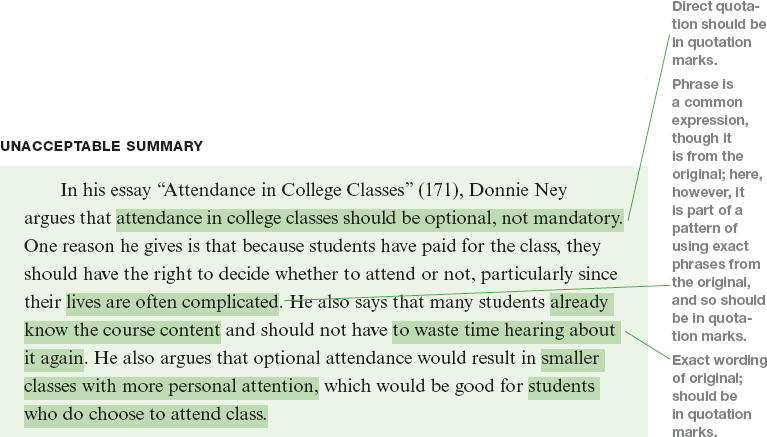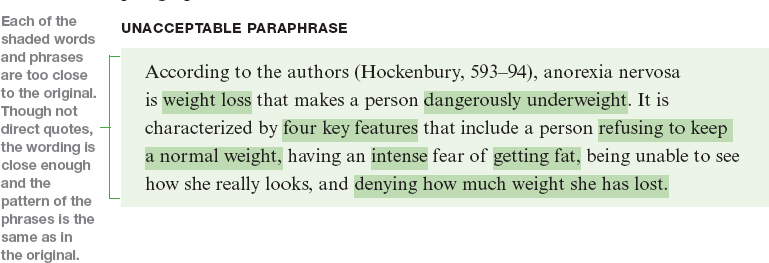Take Careful Notes
As you find information for your research essay, do not rely on your memory to recall details about your sources; take good notes from the start.
Students sometimes plagiarize by mistake because they have taken notes that do not distinguish a source’s ideas from their own or that do not fully record source information, including publication data. For more on how to avoid plagiarism, see “Note: Avoiding Plagiarism” in Chapter 2, and visit the Bedford Research Room at macmillanhighered.com/
NOTE: This section’s advice on recording, citing, and documenting sources reflects Modern Language Association (MLA) style, the preferred style for the humanities.
Keep a Running Bibliography
A bibliography is a complete list, alphabetized by author, of the outside sources you consult. A list of works cited is a complete list, alphabetized by author, of the outside sources that you actually use in your essay.
You can keep information for your bibliography and list of works cited on notecards or on your computer. Whatever method you use, be sure to record complete publication information for each source at the time you consult it; this will save you from having to look up this information again when you are preparing your list of works cited.
The following is a list of information to record for each source.
| BOOKS | ARTICLES | WEB PAGES/OTHER ELECTRONIC SOURCES |
|---|---|---|
| Author name(s) | Author name(s) | Author name(s) |
| Title and subtitle | Title of article | Title of Web page/online material |
| __ | Title of magazine, journal, or newspaper | Title of site/larger work (e.g., online periodical) |
| City of publication and publisher | __ | Name of sponsoring organization OR name of database |
| Year of publication | Date of publication | Date of publication or latest update |
| __ | Page number(s) | Page, section, or paragraph numbers (if provided) |
| __ | Volume number | Date you accessed the site |
| Medium (print) | Medium (print or Web) | Medium (Web/URL, CD) |
Create Clear, Complete Records of Source Information
For each source that you take notes on, create an individual notecard or file on your computer. It should include the source’s author(s) and title, the page number(s) where you found the specific information, and what method you are using to present it: summary or paraphrase (which are called indirect quotations) or direct quotation (which is word for word what the source says). A sample card or entry might look like this.

Indirect Quotation: Summary
As you learned in Chapter 1, a summary is your condensed version of a longer piece of writing, which should include the main point of what you are summarizing. It should also be written as much as possible in your own words, and not by using many of the same words or phrases from the longer source.
One way to include outside source material as evidence or support in your own writing is to summarize. Look back at “Attendance in College Classes” in “Argument in College” in Chapter 13, and then read the two summaries that follow here. The first is unacceptable because it uses too many words and phrases from the original. The second is an acceptable summary.

ACCEPTABLE SUMMARY
In his essay “Attendance in College Classes” (171), Donnie Ney argues that college students should not be required to attend classes because since they have paid for the course, like a consumer purchase, it should be up to the purchaser to use or not use it. He goes on to give other reasons that expand on his basic assumption that students have the right to choose if and when they should attend a class.
The acceptable summary does not use the language of the original, other than those words that refer to the topic. It also focuses on the main point of the piece rather than including all the specific support points. This summary gives the “big picture” of the essay in a condensed form.
Indirect Quotation: Paraphrase
A paraphrase restates another person’s idea in your own words. Unlike a summary, a paraphrase is not necessarily a condensed version of the original; it is the idea expressed in your own words. You cannot paraphrase a whole essay or article. Again, you should not use the same wording or phrasing that is in the original.
Because paraphrasing is a bit tricky, it may be easier for you to quote directly from the original piece. When you are taking notes from a source and find an idea that you might want to use, try writing the idea in your own words, and then look back at the original piece. If what you have written is too close to the words or phrases in the original, either try again or use a direct quotation.
Look back at the essay comparing anorexia and bulimia in “Comparison and Contrast in College” in Chapter 11. The unacceptable and acceptable paraphrases are of information in the first paragraph.

ACCEPTABLE PARAPHRASE
According to the authors (Hockenbury, 593–
The ideas in this paraphrase are the authors’, but the wording is very different from the original.
Direct Quotation
A direct quotation uses information from an outside source word for word, enclosing it in quotation marks (“ ”). Use a direct quotation when it is the best way to support your thesis. Avoid using long direct quotations in a short research essay, however, since most of what you write should be your own words. If you do use a direct quotation that is more than about forty words or four typed lines, indent the whole quotation, and do not use quotation marks.
SHORT DIRECT QUOTATION
According to psychologists Don Hockenbury and Sandra Hockenbury, “four key features define anorexia nervosa” (593).
LONGER DIRECT QUOTATION
Psychologists Don Hockenbury and Sandra Hockenbury explain the disorder of anorexia nervosa this way:
Four key features define anorexia nervosa. First, the person refuses to maintain a minimally normal body weight. With a body weight that is 15 percent or more below normal, body mass index can drop to 12 or lower. Second, despite being dangerously underweight, the person with anorexia is intensely afraid of gaining weight or becoming fat. Third, she has a distorted perception about the size of her body. Although emaciated, she looks in the mirror and sees herself as fat or obese. And fourth, she denies the seriousness of her weight loss. (593–
For more on using quotations correctly, see “Quotation Marks” in Chapter 18.
Again, be certain to include how the information on your notecards is recorded (summary, paraphrase, or direct quotation) and the page number. You may think you will remember, but honestly, you will not. No one does. Rather than preparing good paraphrases, it may be easier to record the idea as a direct quotation. As you draft your essay, you will see that the material is a direct quotation, and you can then take the time to paraphrase carefully.